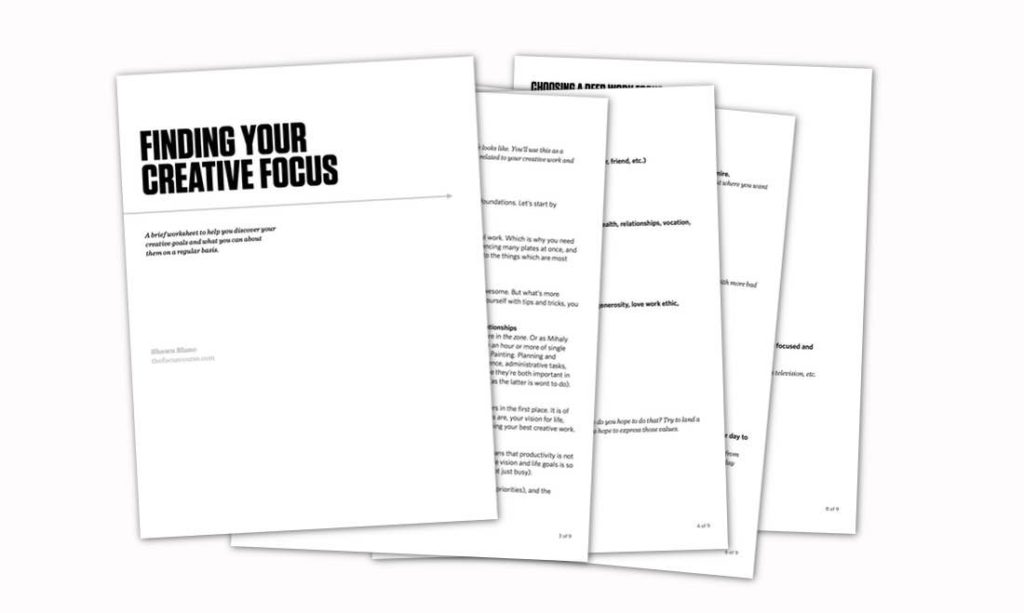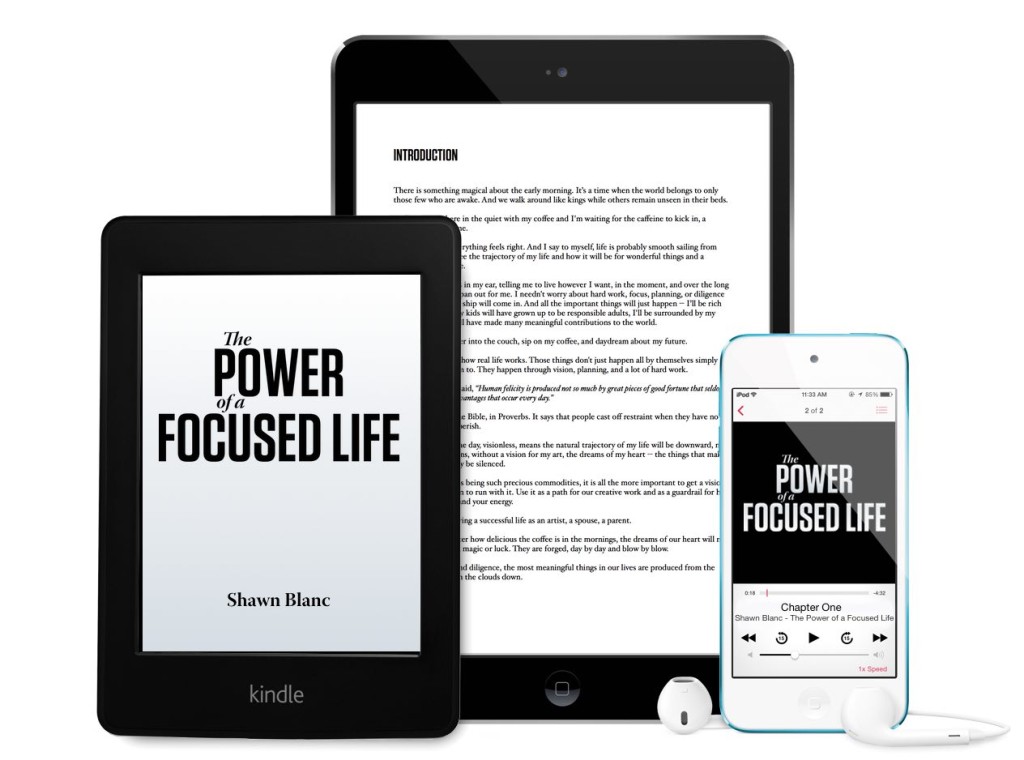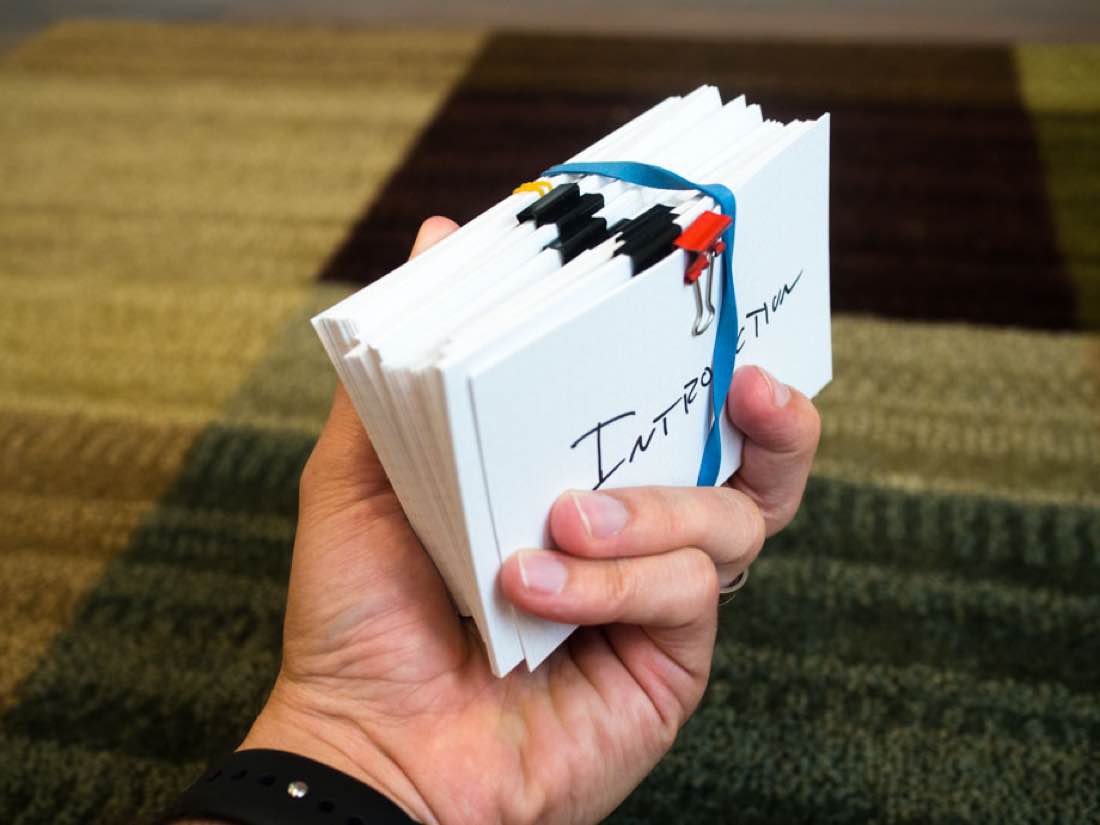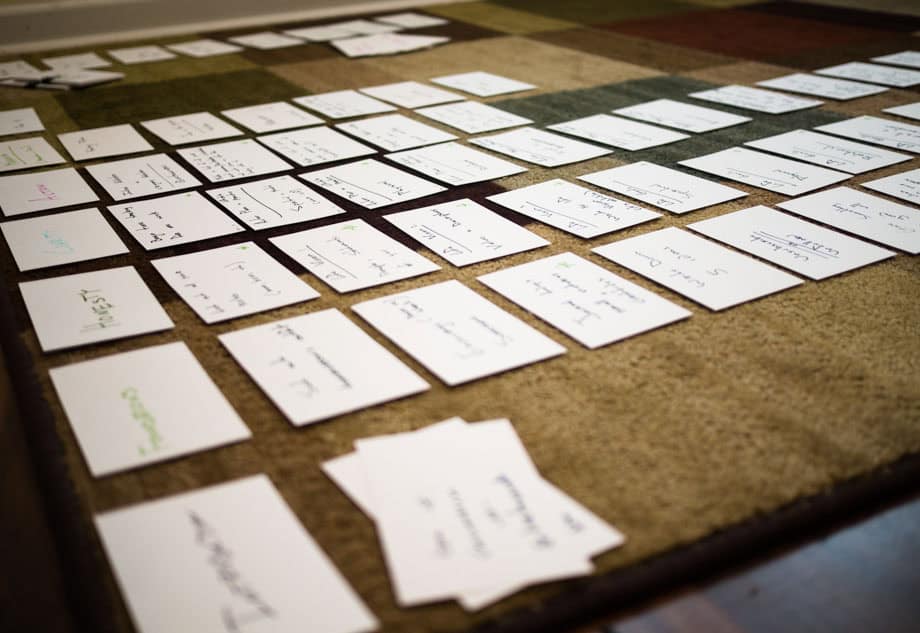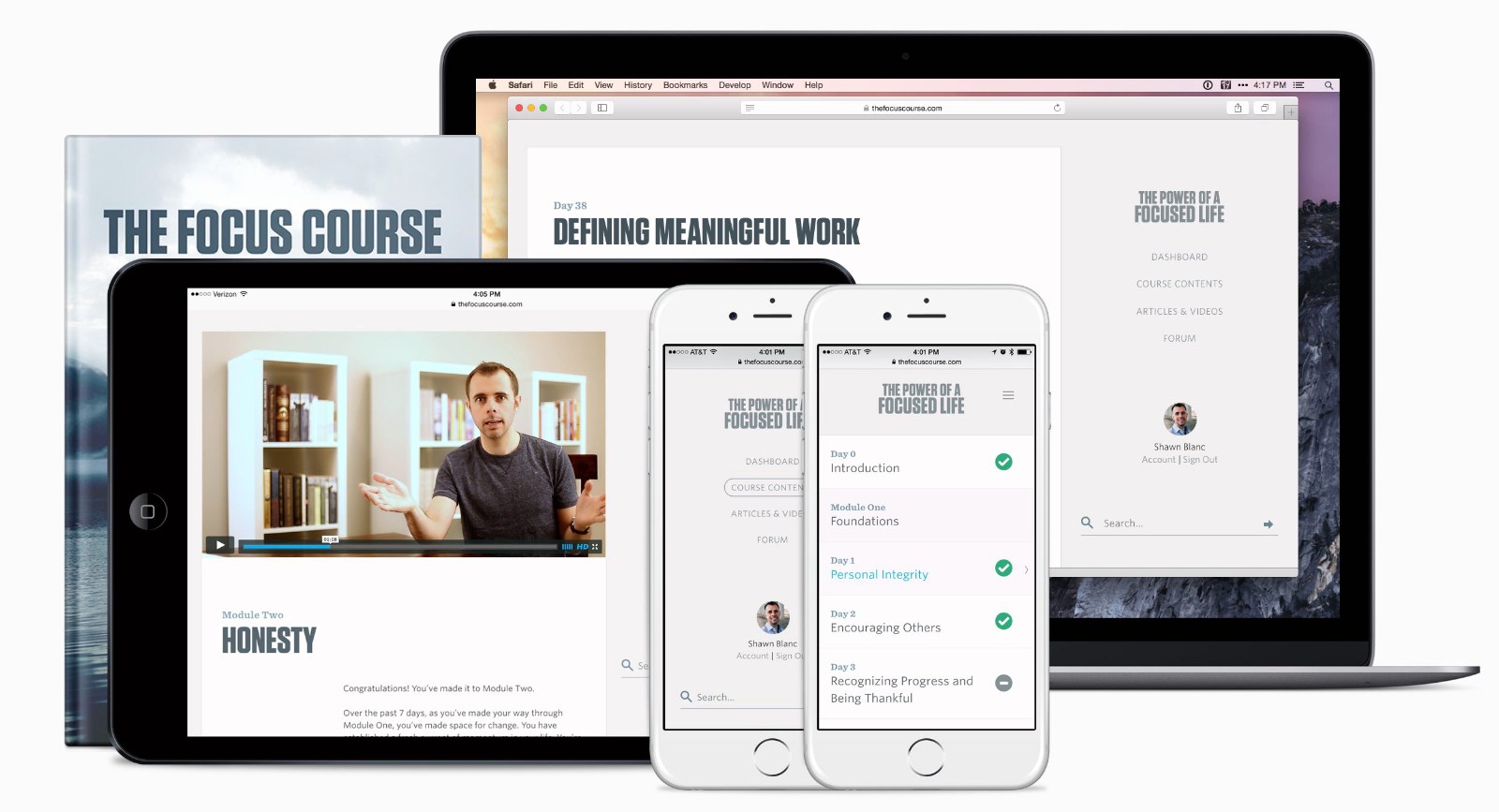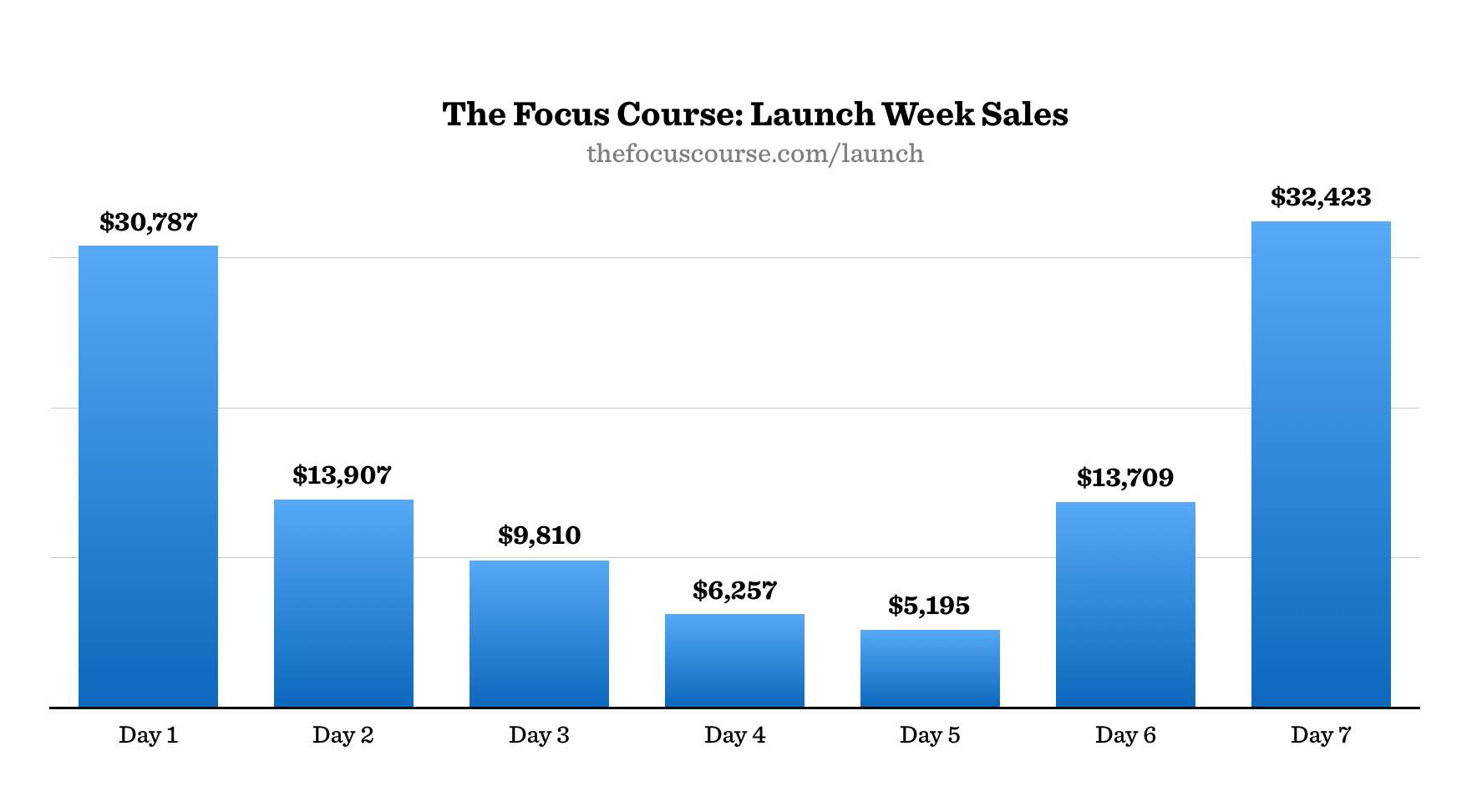CREATING THE COURSE
I architected The Focus Course on 3×5 notecards.
Cracking open a fresh pack of notecards, I wrote down all the individual ideas and topics for the course that I could think of.
I put only one idea, topic, assignment, or lesson per notecard. Then, I laid everything out to survey what was there.
Being able to see it all laid out visually like this proved to be immensely helpful. I could quickly move stuff around and get an idea for the overall flow of the course.
I had 7 “rows” of cards: one for the Introduction, five rows for the five modules, and one row for the conclusion. At first I had just shy of 60 days worth of cards in there, but I knew that I had to keep it to 40 (in the end I cheated by not counting the introduction or conclusion day, so technically it’s 42 days).
The challenge of paring the course from 60 days down to 40 wasn’t easy. Some of the cards I just tossed out altogether. Others I ended up combining. When friends would come over, I’d bring them down to my office and show them the outline and ask what they thought.
Finally, once I had the topics of the 40 days settled, I went through the order. I went through it over and over in my head…
I wanted Day 1 to lead into Day 2 to lead into Day 3, etc. I wanted all of Module 1 to lead into Module 2, and then all of Module 2 to lead into Module 3, and so on.
I wanted there to be an ebb and flow to the lessons, so that the days that were more fun would be interspersed with the more challenging introspective days, etc. And I wanted the course to start with something easy and fun and to end with something fun but challenging.
In short, I considered the information architecture to be just as vital as the contents. The notecards were instrumental in helping get the architecture just right.
With the order of the course finally finished, I started outlining each individual lesson.
As I mentioned, on the front of each card was the focus for each day, and on the back of the card I would put any notes, ideas, and references for that day — but it had to fit on the card. I didn’t want to have so much content that it would be impossible to get through each day’s lesson in a timely manner, so my outlines were literally constrained by the physical size of a 3×5 notecard:
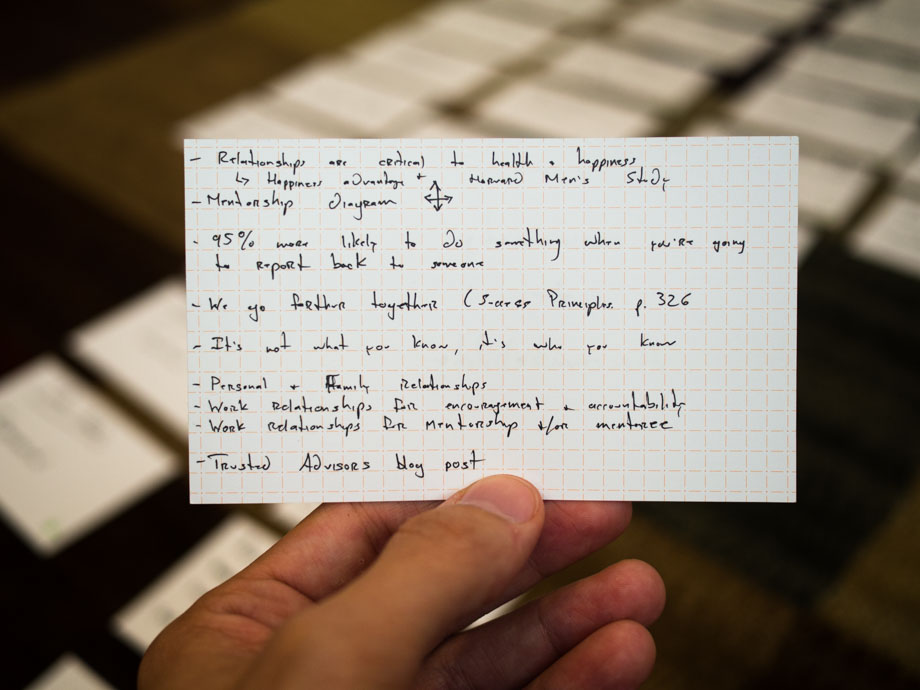
Then, I put the whole stack of cards in order, placed them next to my desk, and started writing. Each day I took the topmost card and wrote the corresponding lesson for the course.
It took me 47 days to write the course. I began on March 19, 2015 and finished on May 5, 2015.
During that month and a half, I wrote 40 daily lessons, plus the course’s introduction, conclusion, and the 5 module overviews: roughly 55,000 words in total — an average of 1,170 words every single day.
It sounds intense, but by this point the writing just flowed because I was so deeply immersed in the topics and content that everything was top of mind.
Plus, thanks to the constraints of the notecards themselves — a single topic with a pre-defined outline — much of the ambiguity involved in the writing process was gone. All I had left to do was expound on the few ideas I had already written down.
This daily writing of the course coincided with my pilot group. I wasn’t just creating the course in a vacuum — I was emailing out each day’s course contents to a group of 90 people.
With the Focus Course announced and most of my research done, I sent an email out to my newsletter list asking for volunteers to take part in the pilot program. I thought it would be a cool way to get people to help me test the content.
There were about 125 applicants, and I picked 75 of them while trying to get a good cross-mix of demographics and careers paths. I also reached out to 15 personal friends and family members and invited them to go through the pilot course as well.
The pilot group was also a way to test the waters of pricing. Was there anyone out there willing to spend money on this thing?
I charged $50 for the pilot course, and that proved to be far too little. What I will do differently for my next course is ask pilot members to pay the full registration price, but offer them additional value, such as group coaching calls only for pilot-members.
The way the pilot program worked is that it was literally just a list in MailChimp. Each day, I would write one lesson for The Focus Course and then email it to the pilot group. I did that every day for 47 days.
In addition to sending out the email to my list, I also posted the lesson as a blog post on the Focus Course website. As readers replied with feedback, typos, etc., I fixed it in real-time on the website.
This small, daily progress proved to be an extremely efficient way to create the course. By the time the pilot program was done, I was 95% done with the course contents as well. All that was left was to refine a few things and then have the text professionally edited.
Originally I was going to charge $79 for The Focus Course. Honestly, I was afraid to charge any more than that.
My friend, Ben Brooks (who was also a pilot member), said I would be crazy to charge so little. He recommended that I charge at least $250.
And my mom, who is always the encourager, said I should charge $500.
I already felt nervous at the idea of charging $79… I just couldn’t imagine that I had the ability to ask people to pay that much for a product.
The hard part of pricing is that because you are so familiar with your work, you struggle to see the true value and worth of what you have to offer. Because you’re so comfortable with your content, it’s not always clear just how much value you actually provide.
The deep familiarity you have with your work is, in fact, what qualifies you to teach it and to charge a fair price for it.
In the end, I decided to sell the course for $249, with a special launch-week price of $199.
Not only did this seem more reasonable to me than $500, but it also meant that people would have skin in the game. At $249, they would have an investment in the course. They’d perceive it at a higher value, and, hopefully, they would actually work through its contents.
Because that’s the whole point! I care as much about delivering the value within the course to my audience as I do about making enough money to keep delivering future value.
We don’t make movies so we can make money. We make money to make more movies.” — Walt Disney
One week before the launch of The Focus Course, everything was ready and in place.
The design and content were finished. The videos were uploaded. The on-boarding welcome emails, the community forums, and the welcome landing page were all done.
But before I opened the doors, I wanted at least a handful of people to sign up and have several days to go through that “first mile” of the course and make sure all the moving parts worked correctly.
To get this second group of pilot members, I reached out to the 50 remaining folks who had previously applied for access to the pilot group but who hadn’t gotten in. I invited them to sign up early at the launch-week price of $199.
But of the 50 people I reached out to, only 7 signed up…
…and that frightened me.
Here were 50 people who had applied just a few months earlier to be a part of the course — these 50 people were my ideal customers, right? They had already expressed their willingness to sign up for the course. Yet response rate was so low. Why?
Turns out, the response rate with this group was low because of the price of the first pilot. Those 50 people had initially been willing to spend $50 on The Focus Course. But now the price was $199.
In their mind, they had anchored the “value” of the course at $50. And so most of them were not willing to spend $199 to sign up. The course felt “too expensive” to them.
But it wasn’t too expensive to everyone else.
As you’ll find out, when I did officially open registration for the course, the $199 price point was hardly a barrier of entry at all. Because for everyone else, they didn’t have a “price anchor” in mind. In fact, many people even felt that the $199 price was so low that it made signing a no brainer.
Two takeaways here:
-
Pricing is an art and a science. There’s no magic formula. But charging too little for your work can be a bigger mistake than charging too much for it.
-
There will always be people who say they are excited about your product and who say they can’t wait to buy it. But then, when the opportunity comes for them to buy, they won’t. There are many reasons as to why (their financial situation has changed, they’re no longer interested, etc.)
With one week to go, I began a Countdown to The Focus Course.
On my website and my email list, I published a series of articles every single day leading up to the Launch of the Focus Course.
I wanted it to be ridiculously obvious that The Focus Course was launching soon, and I was hoping to get people excited about the launch.
Here are the pre-launch emails I sent out to my list of 4,350 people.
- Countdown to The Focus Course (48% opens; sent Sun, June 14)
- Living Without Regret in the Age of Distraction (49% opens; sent Mon, Jun 15)
- You Have Ideas (50% opens; sent Tues, Jun 16)
- The Jolt (50% opens; sent Wed, Jun 17)
- Fight (48% opens; sent Thur, Jun 18)
- An Interview with Tyler Soenen (47% opens; sent Fri, Jun 19)
- Tomorrow: The Focus Course (48% opens; sent Mon, Jun 22)
- Here It Is: The Focus Course (49% opens; sent Tue, Jun 23)
The goal with the first six emails was to build anticipation of the course. In each email I wrote something that was helpful, practical, and valuable (those articles are still today some of the best I’ve written). And then, at the end of each email, I mentioned in the P.S. that the ideas behind that article were just a taste of what would be unpacked inside the Focus Course.
With email number 7, sent the day before launch, I laid out all the details of the course. Nobody knew the full details yet. It’s here that I showed the first screenshots of the members-only areas of the site. I also revealed the pricing and the launch time.
Then, lastly, email number 8 was the launch day email. It was short and sweet, just letting people know the course was now available to purchase.
I highly recommend this strategy of pre-launch sequences.
As you can see from the open rate during launch week, sending out an email every day is not a bad thing — not when you have a story arc and you’re providing something people want.
During these emails that led up to launch day, I was getting replies every day from people saying how much they were enjoying the articles. Several people even asked for early access to the course because they couldn’t wait until launch day.
Here’s a screenshot showing traffic to the website during June 2015.
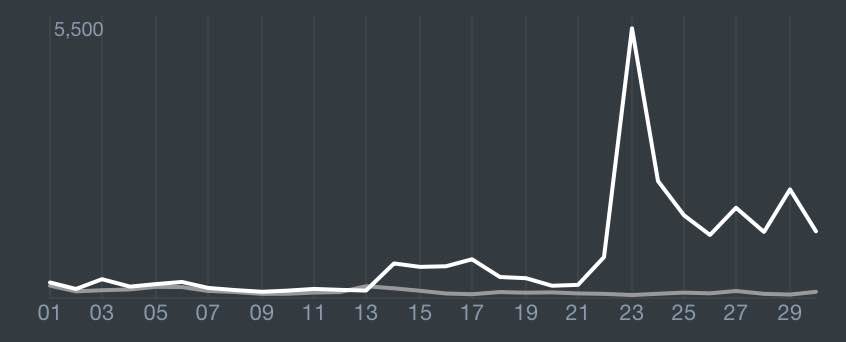
Leading up to the launch, the website was averaging 300 unique visitors per day. On launch day, the site had over 5,000 visitors.
I had no idea how well the course would do or not, but I reached out to Flywheel, Memberful, and Stripe just to make sure. I let each company know that I’d be seeing a rise in traffic and transactions — though I didn’t know how big.
I’ve heard stories of people getting shut down by PayPal or Eventbrite on their big launch day. And while I didn’t expect that to happen, I still wanted to be proactive about even the possibility of it happening. The folks at Flywheel, Memberful, and Stripe were all very helpful.
I even got a couple of emails directly from Drew, the founder of Memberful, on launch day saying that his team was keeping an eye on my account to make sure it kept running smoothly. Thanks, Drew! ?
